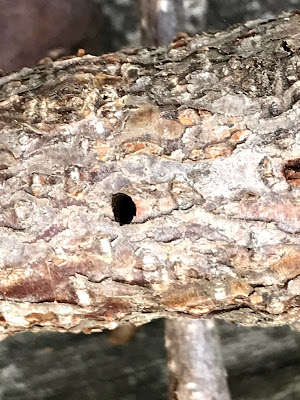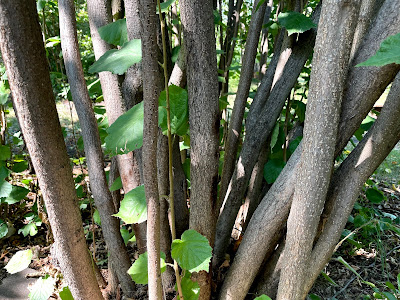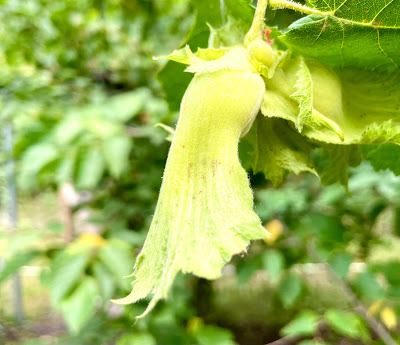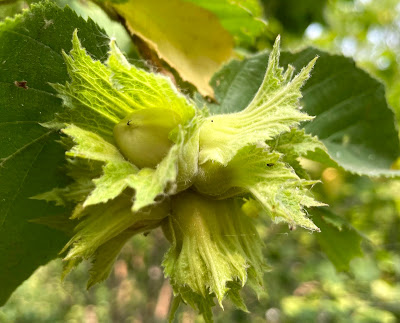A new beetle attacking hybrid hazelnuts
This is one of the jewel beetles, Agrilus pseudocoryli, that can cause the dead and dying branches of wild and hybrid hazelnuts and may be causing damage in the Lino Lakes area.
While visiting my son in Lino Lakes, MN, I noticed some dead branches on his hazelnuts.
Below the dying branch was a swelling of the stem. I also notice dead branches on 3 other hazelnut plants.
There was a D shaped hole just below the enlarged area of the branch.
I shaved off the bark and found that a bark borer had girdled the branch causing the upper part of the branch to die.
I pruned out the dead branches and found the D shape hole in all the branches.
I contacted the Northern MN Hazelnut Cluster group and Brian Aukema, the forest entomologist at the U of M, responded with this information.
Brian Aukema Fri, Jul 30, 4:38 PM |
NORTHERN_MN_HAZELNUT_CLUSTER
Yes, we've noticed increased borer activity this year and have been looking into it. These are native Agrilus beetles (same genus as Emerald Ash Borer) that leave D-shaped exit holes in the stems, usually slightly above cracked stem swellings.
One our technicians, Patrick, has been working with Hailey Shanovich this summer (both copied) and provided this little summary:
"There are at least two species that use hazel as a larval host in our area. The beetle we've been seeing in large numbers is Agrilus pseudocoryli, a species for which there is very little published information. Adult beetles emerge in late spring to early summer - we saw the largest emergence this year around the second week of June in St. Paul and Rosemount. We have noticed the exit holes on a substantial number of dying branches this year."
We are working on quantifying the extent. We did a small feeding assay in the lab, but do not think the adult feeding contributes to branch decline. I'm sure the drought has exacerbated this problem.
I would like to thank the Northern MN Hazelnut Cluster group, Brian Aukema, Lois Braun, and Greg Schwese for their help in identifying this pest.

Not only where their dead branches on the plants, but Japanese Beetles as well.
As you can see they do a good job stripping the leaves.
I'm glad the borer and Japanese Beetles have not made it to my orchard in North Dakota, but I know they're probably moving this way.
One pest I do have is the Hazelnut weevil.
I finally got a good picture of a adult weevil and sent samples to Patrick Beauzay, NDSU Research Specialist, Extension Entomology, who identified the adult weevil as Curculio obtusus, a species that is common on hazelnuts in the eastern U.S. and less common as far west as eastern Manitoba and eastern North Dakota.
This is the larva of the weevil emerging from the hazelnut after the nut was cracked.
This picture was taken on the 6th of August. I had no idea they emerged from the nut so early.
This year the weevil larva has emerged early before I could pick the nuts. I count on controlling the weevil by picking the nuts as early as possible and catching them in trays on my drying racks. This technique may not work anymore if the weevil larva as already left the nut a week before they're picked.
I might have to look into other options for controlling this pest.
This is another type of weevil identified by Pat Beauzay as a Green Immigrant Leaf Weevil. The adult green weevils feed on leaves and the larvae feed on roots.
I think they may be damaging the immature nuts when they're small because I found them inside the husk next to a damaged nut. I also found many of them hiding in the husk next to the mature nuts.
Early squirrel damage
I was surprised to see so much squirrel damage this early until I checked the hazelnut plant and found some were ready to be picked.
Here is my first plant that I harvested which is a week earlier than last year.
I think it was either due to the early warm weather this spring or this year's hot dry summer.
I estimate the squirrels removed about half the nuts before I got there.
Here I am picking hazelnuts and trying to stay ahead of the squirrels.
This is a close up of the hazelnut cluster. Before picking the cluster of nuts I always make sure the nut rolls easily out of the husk. Just below my hand are the catkins developing which will pollinate next years crop in the spring.
This is a close up of the catkins (male flowers). I pay close attention to their location and try not to remove them when picking the hazelnuts.
Here I'm showing the general height of this hazelnut plant. This plant may be about 20 ft tall.
This is the base of that same plant. I plan on removing the center stems, because they have started to produce smaller and less nuts than the stems on the outer portion of the plant.
Could it be possible that the outside stems are girdling the center stems?
Different types of hazelnut husks (involucre)
This one has a long leafy inclosed husk almost like a Beaked Hazelnut.
This one has more of an open leafy husk and it's one of my best plants with a large nut that separates easily form the husk.
This one has more of a thick juicy husk that is hard to dry down and it tends to dry around the nut making it hard to separate the husk form the nut.
Here we have a husk that almost aways stays on the plant and the nut will just fall out when ripe. These are similar to the European Hazelnuts that are swept off the ground.
This is another one of my better plants with a large nut that separates easily from the husk.
The husk here is from a wild American Hazelnut which drys around the nut and the husk has to be pealed away from the nut which is a little tough on the fingers.
This is one I prefer not to pick and the squirrels will not usually touch these until all the other hazelnuts are gone.
Here is another open husk in which the nut easily drops out.
The husk here is one that tends to dry around the nut but is easier to remove in the mechanical separator.
This one has a smaller nut that drops out of the leafy husk.
On this plant I lay a tarp down and shake each stem. The ones left on the plant I remove by hand.
This is the one I hate the most with the small sticky hairs on the outside of the husk and when dried down the husk becomes a hard covering. This is one the squirrels will not touch and when dry the squirrels burry the whole husk and nut.
Another harvest under way for 2021.
The green house, aka drying shed, makes a safe place away from all the pests to dry down hazelnut clusters.






























How do you pick nuts off of bushes 20 ft high? The bushes I got from you 4 years ago produced a few nice nuts this fall. The seed from you two years ago germinated and the little bushes are thriving here in NE Iowa. Will they reach 20 feet?
ReplyDeleteThe stems of hazelnut plant bend easily. To pick this tall plant each stem is bent over and the nuts are shaken onto a tarp and the rest are picked by hand. Your plants probably have a good chance of getting that high in 10 years, but most of the plants in the orchard are about 10 feet high.
ReplyDeleteI'm impressed by your hazelnuts that I've planted in Iowa. I also planted a half dozen near Oakes. After four years they are less than waist high and not doing much more than survive. Could it be the sandy soil, or the drier weather?
ReplyDeleteappreciate the update, enjoy watching your progress
ReplyDelete